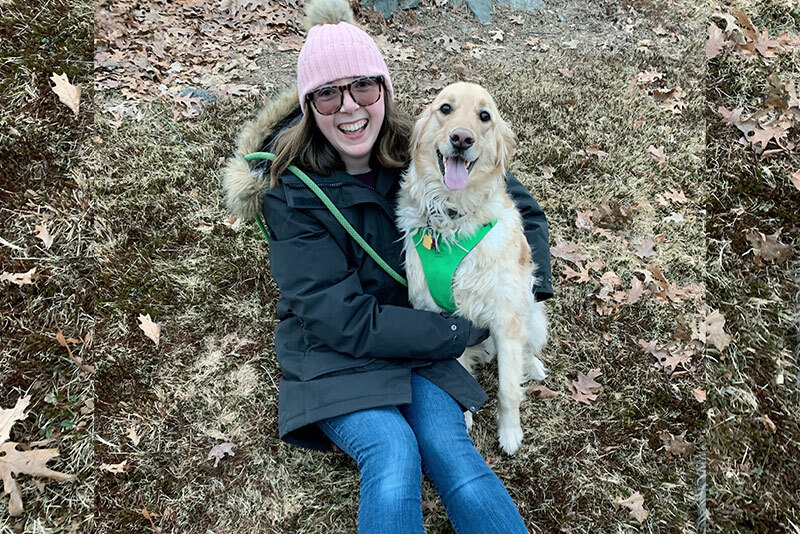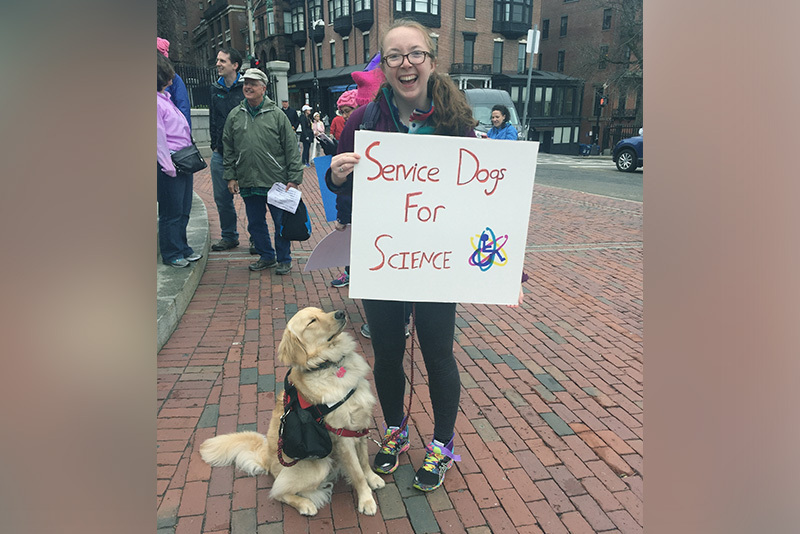Interventional techniques help Molly thrive with chronic pain

Molly McGowan loves baking, sewing, and taking daily walks in the woods with her goldendoodle, Cooper. But Cooper isn’t just any pet. He’s her service dog and a significant source of support. “I credit him with helping me get up and move every day,” she says.
It isn’t always easy. For Molly, pain has been a constant and unwelcome presence for most of her life. At age 8, she was diagnosed with a connective tissue disorder that is associated with chronic pain. When she was 13, her abdominal pain became so intolerable that she was unable to eat and was hospitalized — yet clinicians were still puzzled. “No one could pin down exactly what was causing it,” she remembers. That began to change when she was referred to Dr. Pradeep Dinakar, director of the Pediatric Interventional Pain Program at Boston Children’s Hospital.

An interventional approach to pain
After years of testing and a piling list of diagnoses, Dr. Dinakar diagnosed Molly with small fiber neuropathy, an inflammatory nerve-related condition that causes severe pain in her peripheral nerves and gastrointestinal tract. A combination of medication, physical therapy to strengthen her muscles and reduce spasticity, and various other treatments prescribed by Dr. Dinakar have helped keep the condition under control. “He’s helped me manage the pain in a way that has allowed me to participate in life,” she says.
At the same time, Molly has lived with an additional source of pain: anterior cutaneous nerve entrapment syndrome, or ACNES. In this underrecognized condition, certain nerves become trapped in the abdominal muscles and connective tissue, leading to chronic abdominal pain. After diagnosing her with ACNES in 2015, Dr. Dinakar was initially able to keep the pain from ACNES at bay by using transversus abdominis plane (TAP) nerve blocks. In this approach, a physician injects an anesthetic into the abdominal muscles to interrupt pain signals from the affected nerves.
While quarterly TAP blocks “did away with the pain” for about two years, “eventually that began to change,” says Molly. To address it, Dr. Dinakar referred her to one of his colleagues, surgeon Dr. David Mooney. Dr. Mooney performed abdominal nerve resection surgery —cutting the affected nerves to stop the pain signals. This procedure has had lasting benefits for Molly. “It has essentially cured my ACNES,” she says.

‘Do things anyway’
Now 25, Molly still sees Dr. Dinakar to help manage the pain associated with small fiber neuropathy, inflammatory arthritis, and her other conditions; she also receives care from Dr. John Lee, who treats her for mast cell disease, an interrelated allergic condition. When she isn’t hanging out with Cooper and enjoying her hobbies, she’s pursuing her master’s degree in management from Harvard University.
It’s a path Molly says both Dr. Dinakar and her mother have helped her forge. “They’ve encouraged me to do things anyway, so that I don’t let the pain dominate my life,” she says. That approach continues to influence the way Molly views pain and her ability to function. “It can be tempting to focus on your life after pain, but that’s thing about chronic pain — it’s chronic,” she explains. “I want to focus on what I can do, not what I can’t.”
Learn more about the Pediatric Interventional Pain Program.
Related Posts :
-

Get answers about your child's chronic pain
[smartslider3 slider="8"]
-

Chronic headaches in kids: How a psychologist can help your child cope
For many young people, the pain of chronic daily headaches can be compounded by the concern that providers aren’t ...
-

Interventional pain techniques bring Sadie relief
It’s hard for Sadie Doherty and her parents to remember a time when she hasn’t been in pain. ...
-

Minimally invasive approaches help ease Sydney's chronic pain
Sydney Hart wants to reimagine the traditional “handicap” symbol. In her online shop, she offers pins, stickers, and other products ...





